Arresting Time
by
Bob Brooke
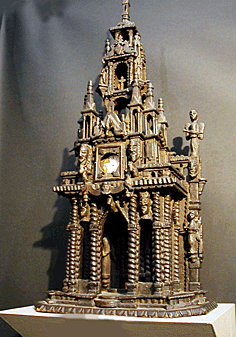 During the 19th Century people used pocket watch holders, often referred
to as a watch hutches, to put their pocket watches in overnight to
protect them from loss or damage. These watch holders also converted any
pocket watch into small table or mantel clocks in a room that usually
didn't have a clock. They also made perfect bedside clocks, before the
advent of alarm clocks. During the 19th Century people used pocket watch holders, often referred
to as a watch hutches, to put their pocket watches in overnight to
protect them from loss or damage. These watch holders also converted any
pocket watch into small table or mantel clocks in a room that usually
didn't have a clock. They also made perfect bedside clocks, before the
advent of alarm clocks.
The French called them porte montre, meaning “watch stand.”
Parisian artisans fashioned ornate watch holders for wealthy travelers
visiting Paris on the Grand Tour. Pocket watches were a necessity during
this era and fine shops along the Palais Royal specialized in selling
unusual and whimsical accessories to house family pieces at the end of
the day.
History
Pocket watch holders spanned all decorative styles, from Neoclassical to
Regency and on to the opulence of Napoleon III. After the 1860s, watch
holder makers explored the styles of the day, such as Rococo Revival and
Renaissance Revival. As the new century dawned, artisans created
beautiful renditions in the styles of Art Nouveau and Arts and
Crafts—and by the mid-1920s, Art Deco.
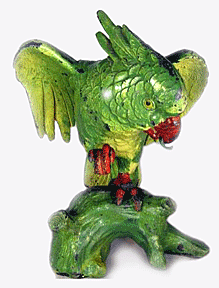 By the late 19th century watch holders could be found in a vast variety
of shapes and forms. Champlevé enamel work was especially popular.
Champlevé is an enameling technique in which craftsmen carved, etched,
die struck, or cast troughs into the surface of a metal object, then
filled these troughs with vitreous enamel. They then fired the piece
until the enamel fused, and when cooled, polished the surface of the
object. The uncarved portions of the original surface remained visible
as a frame for the enamel designs. The name, champlevé comes from the
French for "raised field," or background, though the technique in
practice lowers the area to be enameled rather than raising the rest of
the surface. By the late 19th century watch holders could be found in a vast variety
of shapes and forms. Champlevé enamel work was especially popular.
Champlevé is an enameling technique in which craftsmen carved, etched,
die struck, or cast troughs into the surface of a metal object, then
filled these troughs with vitreous enamel. They then fired the piece
until the enamel fused, and when cooled, polished the surface of the
object. The uncarved portions of the original surface remained visible
as a frame for the enamel designs. The name, champlevé comes from the
French for "raised field," or background, though the technique in
practice lowers the area to be enameled rather than raising the rest of
the surface.
Materials
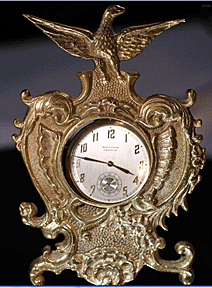 During
the second half of the 19th Century, cast iron was the most common
material for making pocket watch holders. Artisans covered these
unsightly cast pieces with gilded bronze to simulate gold. Artisans
sculpted the original designs to represent forms in nature, such as
vines and leaves or figural representations of country life. Mounted on
a marble base and standing between 7 and 8 inches tall, they were quite
heavy. During
the second half of the 19th Century, cast iron was the most common
material for making pocket watch holders. Artisans covered these
unsightly cast pieces with gilded bronze to simulate gold. Artisans
sculpted the original designs to represent forms in nature, such as
vines and leaves or figural representations of country life. Mounted on
a marble base and standing between 7 and 8 inches tall, they were quite
heavy.
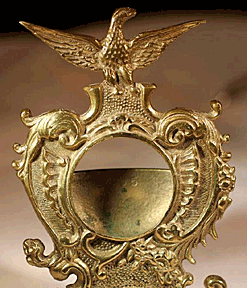 Each holder featured either a round frame with a metal pocket in which
to place the watch, or a metal hook from which to hang it. Fanciful
designs often featured Baroque cherubs. Each holder featured either a round frame with a metal pocket in which
to place the watch, or a metal hook from which to hang it. Fanciful
designs often featured Baroque cherubs.
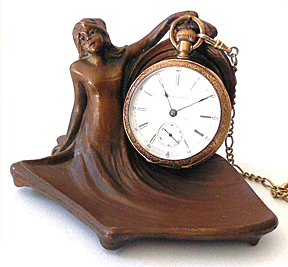 Craftsmen cast less expensive versions in spelter, a heavy zinc and lead
alloy, over which they applied a bronze wash or brightly colored paint.
They sculpted the originals of animals or single figurines. One example
shows a peasant girl carrying a garland wreath. Another depicts a young
girl in a sheer, swirling dress which swirls in front to form a tray for
cufflinks, watch chain, or coins. Still another example, depicts a
parrot either about to land on or take off from a branch and painted a
bright chartreuse and red. Craftsmen cast less expensive versions in spelter, a heavy zinc and lead
alloy, over which they applied a bronze wash or brightly colored paint.
They sculpted the originals of animals or single figurines. One example
shows a peasant girl carrying a garland wreath. Another depicts a young
girl in a sheer, swirling dress which swirls in front to form a tray for
cufflinks, watch chain, or coins. Still another example, depicts a
parrot either about to land on or take off from a branch and painted a
bright chartreuse and red.
Parisian Artisans
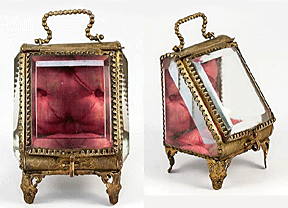 However, Parisian artisans created some of the most elaborate pocket
watch holders. Resembling a larger version of the famed Limoge porcelain
box, these became known as a casque porte montre, or pocket
watch casket. However, Parisian artisans created some of the most elaborate pocket
watch holders. Resembling a larger version of the famed Limoge porcelain
box, these became known as a casque porte montre, or pocket
watch casket.
Developed in the late 19th Century, these little gems usually often
featured a beveled glass box mounted on sculpted brass legs. While some
had an eglomise, or back painted view of Paris, most were clear
glass.
One fine example is a French cristal d' opale rose “hortensia” or
“gorge de pigeon,” hand embellished with raised enamel flowers
and gilt accents. The rich iridescent pink “hortensia” opaline glass is
beautifully supported by delicate ormolu mounts.
The bourgeoisie of Paris in the 1860s, during the reign of Napoleon III,
loved all things mythological and Greek inspired. Classic
elements of mythology appeared in design motifs on small items such as
watch holders, as well as larger pieces of furniture.
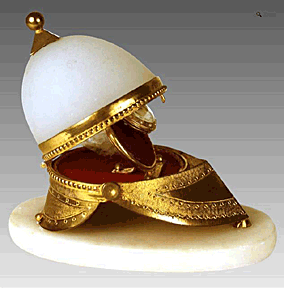 One of the more unusual examples of a watch casket originated during the
gilded age of Napoleon III. Made in the form of a soldier's helmet which
sits on a white marble base, its hand cut gilded brass is meticulously
tooled to form the front and back of the hat. The crown of the helmet is
of white opaline, with a gilded brass finial. It has a hand tooled
gilded mount at the bottom. The helmet top opens to reveal a pocket
watch holder mounted with a gilded brass frame. A "U" shaped hook at the
top holds the watch while the interior, lined with red velvet, is
typical of this opulent period. One of the more unusual examples of a watch casket originated during the
gilded age of Napoleon III. Made in the form of a soldier's helmet which
sits on a white marble base, its hand cut gilded brass is meticulously
tooled to form the front and back of the hat. The crown of the helmet is
of white opaline, with a gilded brass finial. It has a hand tooled
gilded mount at the bottom. The helmet top opens to reveal a pocket
watch holder mounted with a gilded brass frame. A "U" shaped hook at the
top holds the watch while the interior, lined with red velvet, is
typical of this opulent period.
Another example depicts a French Vernis Martin style enameled metal
miniature sedan chair, with beveled glass windows, adorned with Putti
angels. .
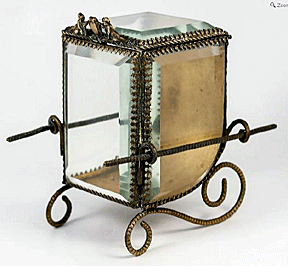 Still
another fine example begins with a very fancy gilded brass/bronze
frame. The upper frame has a repeating egg and dart pattern. At the
bottom two winged gryphon raise their paws towards a central flaming
urn. The very fine and intricate detailing to the creatures depicts
muscle structure, feathers and facial details. Above this flowers and
leaves fill two cornucopia, crossing at the center bottom. A large
circle frames a concave medallion for the watch to rest upon. Still
another fine example begins with a very fancy gilded brass/bronze
frame. The upper frame has a repeating egg and dart pattern. At the
bottom two winged gryphon raise their paws towards a central flaming
urn. The very fine and intricate detailing to the creatures depicts
muscle structure, feathers and facial details. Above this flowers and
leaves fill two cornucopia, crossing at the center bottom. A large
circle frames a concave medallion for the watch to rest upon.
Pocket watch holder makers also produced dramatic designs drawn from
Nature. On one example, an eagle with its wings outspread and perched on
a festoon of arrows and laurel leaves, holds an elongated hook. The top
of the piece has a very large cartouche made of two curved cornucopia
and a central swan, with neck curved downward, perched on a fleur de lis.
A half-moon festoon of laurel leaves flow from one cornucopia to the
other.
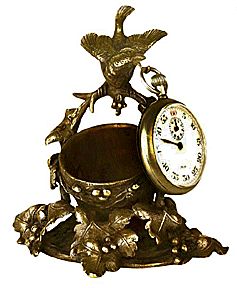 Also originating in Paris is cast bronze watch holder, designed by
19th-century French artist, Emile Joseph Carlier, featuring a little
bird alighting atop a cascading vine of leaves which spill onto the base
of the bottom mount. The detail of the little bird—its feathers, sweet
expression, and outstretched wings give him a very lifelike appearance.
In his beak he holds a curved stick onto which to hang a watch. A
half-egg shape bowl, ornamented with leaves and berries, which could
hold coins or other jewelry items, rests below him. Also originating in Paris is cast bronze watch holder, designed by
19th-century French artist, Emile Joseph Carlier, featuring a little
bird alighting atop a cascading vine of leaves which spill onto the base
of the bottom mount. The detail of the little bird—its feathers, sweet
expression, and outstretched wings give him a very lifelike appearance.
In his beak he holds a curved stick onto which to hang a watch. A
half-egg shape bowl, ornamented with leaves and berries, which could
hold coins or other jewelry items, rests below him.
Yet another, made of bronze/metal, features painted detailing to give
the effect of fine porcelain. The chubby little body of a cherub with
his hands outstretched stands on a cradle made from an egg. He has
delicate wings and wears a quiver around his waist, as well as delicate
detailing to his fingers and toes and the feathers of his wings. His bow
serves as the support for the pocket watch, which hangs beautifully
within the sculpture design.
For the Ladies
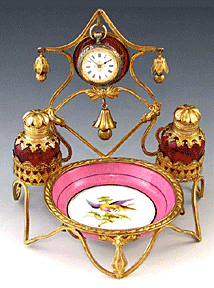 While artists created the majority of pocket watch holders to hold the
larger watches carried by men, they also designed a number of them
specifically for women. While artists created the majority of pocket watch holders to hold the
larger watches carried by men, they also designed a number of them
specifically for women.
A fine example is a 19th-century French vanity perfume caddy, with
pocket watch holder and pin dish. Composed of gilt bronze or brass
metal. Decorative framework encircles a ceramic Sevres style pin dish
hand painted with a colorful bird trimmed with pink border. A pair of
perfume bottles are of rich cranberry glass, topped by gilt bronze
ornamental collars and hinged lids, opening to reveal original tiny
glass stoppers. A holder for a pocket watch and three decorative metal
tassels or dangles finish off the piece.
This multipurpose vanity or dresser
trinket most likely originated as a whimsical Parisian souvenir from one of the many
exquisite boutiques that lined the Palais Royal.
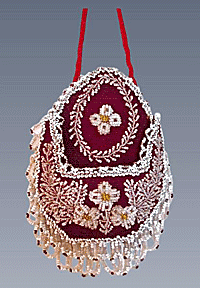 Another
unique watch holder could have been used by either a man or a woman. Exquisitely
hand made by a genteel Victorian era lady in 1880 is a beadwork pocket
watch holder, intended for her husband to place his prized pocket watch
in when retiring for the evening. Hung in a man's dressing room, he
would undress for the night and place his watch into this hanging pocket
for safe keeping till morning. It has small glass beads intricately
stitched, onto a deep wine red wool cloth made for the purpose, into a
delicate floral pattern. The glass beads are clear, white, silver, gray
and yellow. Beadwork surrounds the edges with a wreath design at the top
with flower at the center. On the body of the pocket lie three flowers
with large leaves on either side. A looped fringe hangs from the bottom
half. Another
unique watch holder could have been used by either a man or a woman. Exquisitely
hand made by a genteel Victorian era lady in 1880 is a beadwork pocket
watch holder, intended for her husband to place his prized pocket watch
in when retiring for the evening. Hung in a man's dressing room, he
would undress for the night and place his watch into this hanging pocket
for safe keeping till morning. It has small glass beads intricately
stitched, onto a deep wine red wool cloth made for the purpose, into a
delicate floral pattern. The glass beads are clear, white, silver, gray
and yellow. Beadwork surrounds the edges with a wreath design at the top
with flower at the center. On the body of the pocket lie three flowers
with large leaves on either side. A looped fringe hangs from the bottom
half.
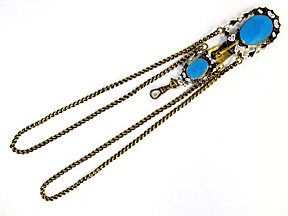 Many Victorian women wore chatelaines and hung their diminutive pocket
watches from them. Most were about 8 inches long, with a top central
portion fixed to a belt hook on the back and a traditional watch hook on
the front. Many Victorian women wore chatelaines and hung their diminutive pocket
watches from them. Most were about 8 inches long, with a top central
portion fixed to a belt hook on the back and a traditional watch hook on
the front.
Souvenirs of the Grand Tour
Specifically designed and carved as souvenirs are a group of pocket
watch holders from towns in the 19th-century "Black Forest" area of
Switzerland, Germany, parts of France and Italy, where they pleased
travelers on the Grand
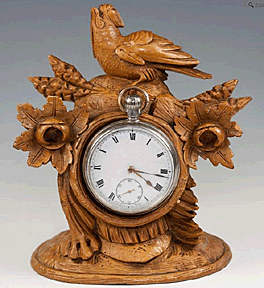 Tour. These hand carved treasures range from
whimsical small bears to large watch holders and wall plaques showing
the most realistic anatomical studies of stag, fowl, and "fruits of the
hunt." Tour. These hand carved treasures range from
whimsical small bears to large watch holders and wall plaques showing
the most realistic anatomical studies of stag, fowl, and "fruits of the
hunt."
Travelers on the Grand Tour would have also visited England where they
would have discovered delightful pocket watch holders made the potteries
of Staffordshire. Featuring miniaturized figures similar to those on
larger Staffordshire pieces, these watch holders often featured women
and children in folksy scenes, much like their larger counterparts. One
features a child climbing a tree to get bird eggs from nest while the
mother bird sits on top. At 11 inches high, these Staffordshire pieces
were somewhat larger than those made in Paris.
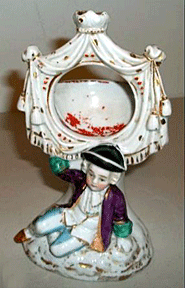 Another
shows a boy, his hair is coifed in powdery white curls, wearing a black
tri-corner hat, a long purple coat with green cuffs along with a white
vest and blue pants, sitting and holding up the watch holder. Another
shows a boy, his hair is coifed in powdery white curls, wearing a black
tri-corner hat, a long purple coat with green cuffs along with a white
vest and blue pants, sitting and holding up the watch holder.
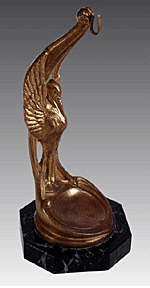 One
of the most important French artists of the 1920s, Maurice Frecourt,
known for his animal sculptures, produced watch holders in the sleek
style of Art Deco. After the Exposition Internationale des Arts
Décoratifs et Industriels Modernes in Paris in 1925, designers embraced
the geometric style of Art Deco. One of his watch holders features a
stylized bird standing at the edge of a bowl with its wings up and
touching and mounted on a black and green veined piece of octagonal
marble. He engraved this piece with detailed feathers both in front and
in the back. One
of the most important French artists of the 1920s, Maurice Frecourt,
known for his animal sculptures, produced watch holders in the sleek
style of Art Deco. After the Exposition Internationale des Arts
Décoratifs et Industriels Modernes in Paris in 1925, designers embraced
the geometric style of Art Deco. One of his watch holders features a
stylized bird standing at the edge of a bowl with its wings up and
touching and mounted on a black and green veined piece of octagonal
marble. He engraved this piece with detailed feathers both in front and
in the back.
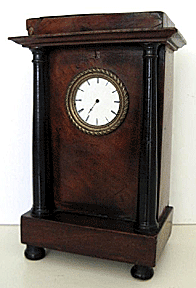 Some pocket watch holders imitated other clock cases, only in miniature.
Each evening the pocket watch owner placed his watch into the hole where
the clock face would be. Some pocket watch holders imitated other clock cases, only in miniature.
Each evening the pocket watch owner placed his watch into the hole where
the clock face would be.
All the pocket watch holders mentioned in this article are for sale from
various dealers at
RubyLane.com
for prices ranging from $60 for a simple cast-iron holder to $975 for
the painted cast-iron parrot.
To read
more of my articles, please
visit
my Web site.
<
Back to Antiques Articles
Next Article >
|
